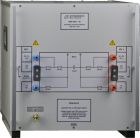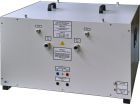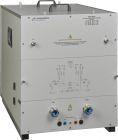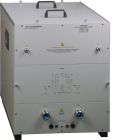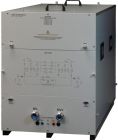Battery Simulator
- Details
BNB 8651-40 - Battery Simulator
|
|
The purpose of this battery impedance network (BNB) is to provide electric power to the device under test, providing a standard impedance. It has been developed for automotive tests. A resistor that emulates the internal battery resistance is implemented in the BNB.
A battery could be simulated by different internal resistors. There are four possible values implemented: 2 x 100 mΩ, 2 x 50 mΩ, 2 x 25 mΩ and 2 x 10 mΩ (with one resistance per path).
|
||||||||||||||||||||||||
- Details
BNB 8652 - HV Line Stabilisation Network
|
|
A LISN, implemented as a battery impedance network here, shall supply electric power to the device under test and provide a standardized impedance. It has been developed for automotive tests e.g. to fulfill the requirements of the manufacturer standard "MBN 11123".
A Battery could be simulated by various internal resistors. There are three possible values: 2 x 100 mΩ, 2 x 50 mΩ, 2 x 25 mΩ (one resistance in each path).
|
||||||||||||||||||||||||||||||
- Details
BNB 8653
|
|
The battery simulator BNB 8653 has the task of supplying power to the device under test (vehicle components) while ensuring a defined source impedance. It is designed for tests in the automotive sector.
The BNB 8653 is constructed symmetrically with two paths, HV+ and HV-, with variable power resistors in each path. A battery can be simulated by various internal resistors. Four possible values are available for
|
||||||||||||||||||||||||
- Details
BNB 8654 - Battery Simulator
|
|
LISN, implemented as a battery impedance network here, shall supply electric power to the device under test (DuT) and provide a standardized impedance. It has been developed for automotive tests e.g. to fulfill the requirements of the manufacturer standard "MBN 11123".
The BNB 8654 is constructed symmetrically with two paths, “HV+” and “HV-“, with variable power resistors in each path. A battery can be simulated by various internal resistors. Three possible values are available for Rint: 2 x 50 mΩ, 2 x 25 mΩ and 2 x 10 mΩ (one resistor in each path). The built in components have no specific polarity. The paths are isolated from the housing.
|
|||||||||||||||||||||||||||
- Details
BNB 8655
|
|
The battery simulator BNB 8655 has the task of supplying power to the device under test (vehicle components) while ensuring a defined source impedance. It is designed for tests in the automotive sector.
The BNB 8655 is constructed symmetrically with two paths, HV+ and HV-, with variable power resistors in each path. A battery can be simulated by various internal resistors. Three possible values are available for
|
||||||||||||||||||||||||
- Details
BNB 8656 - Battery Simulator
|
|
A LISN, implemented as a battery impedance network here, shall supply electric power to the device under test (DuT) and provide a standardized impedance. It has been developed for automotive tests.
The BNB 8656 is constructed symmetrically with two paths, “HV+” and “HV-“, with variable power resistors in each path. A battery can be simulated by various internal resistors. Five possible values are available for Rint: 2 x 100 mΩ, 2 x 60 mΩ, 2 x 50 mΩ, 2 x 25 mΩ and 2 x 10 mΩ (one resistor in each path).
|
|||||||||||||||||||||||||||



